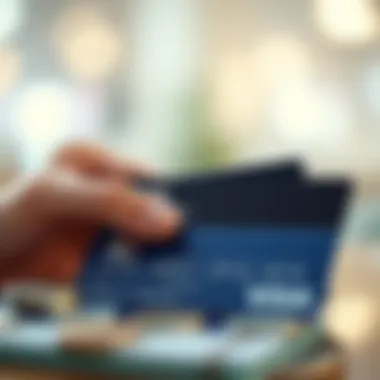Understanding Double Paid Credit Cards: A Deep Dive


Intro
Navigating the world of credit cards can sometimes feel like trying to find your way out of a maze. Among the many potential pitfalls, double payments present a unique challenge that can leave consumers scratching their heads. Imagine receiving your credit card statement and realizing that you’ve paid the same bill twice in one cycle. It’s a frustrating and often bewildering experience that deserves closer scrutiny.
Double paid credit cards, or the phenomenon of accidentally making multiple payments, can stem from several factors. Think about it: a sneaky automatic payment set and a manual payment made in the same span could lead to this mishap. These occurrences may appear insignificant, yet they can significantly impact an individual’s finances and mental well-being.
This section aims to break down the crucial elements related to double payments, shedding light on the complexities behind them. With insights into not only why these double payments occur but also their repercussions and pathways to resolution, readers can arm themselves with the necessary knowledge to tackle any future credit card dilemmas head-on.
Foreword to Double Paid Credit Cards
In the landscape of personal finance, the phenomenon of double payments on credit cards poses not just a minor inconvenience but potentially significant financial repercussions. Understanding double payments is crucial for anyone who uses a credit card, as it touches on various elements of consumer rights, financial planning, and overall money management. Each year, countless consumers grapple with their credit statements, discovering, often too late, that they have inadvertently paid more than their debts require. This topic is not merely about numbers; it's about safeguarding one’s financial stability and peace of mind.
Defining Double Payments
Double payments can be succinctly defined as instances where a financial obligation, specifically to a credit card, is mistakenly settled more than once. This can happen in various ways: you may process a payment online, only to submit another payment either by mail or in-person without realizing your previous action. The resulting issue is not just the headache of reconciling accounts; rather, it can lead to loss of liquidity and unnecessary fees that erode financial well-being.
It’s essential to recognize that double payments often stem from confusion in payment mechanisms. Some might think they haven’t paid their dues when, in fact, the transaction went through. Thus, clear definitions and understanding are vital, as they set the foundation for recognizing and subsequently solving this issue.
Common Scenarios Leading to Double Payments
There are several scenarios where double payments can emerge, often rooted in a mix of technology and human oversight. Here are some of the more common occurrences:
- Payment Processing Delays: On occasion, you might initiate a payment that appears pending in your account. Assuming there was a glitch, you may end up submitting another payment, thinking the first one did not process.
- Multiple Payment Platforms: Many consumers pay their credit card bills through various platforms, such as banking apps, credit union websites, or directly through the card provider’s portal. This can lead to miscommunication about whether a payment has been submitted.
- Family Member Miscommunication: When shared accounts are involved, a simple misunderstanding between family members can result in duplicate payments. One person thinks they are handling the payment, while another inadvertently does the same.
- Poor Record-Keeping: If you’re not diligent about keeping track of your payments and balances, it’s easy to lose track and pay more than once for the same period.
"Understanding the triggers for double payments can help prevent financial slip-ups that could hurt your credit profile."
Navigating double payments is often more than just balancing books; it’s a matter of steering through the complexities of modern payment systems layered with human error. Grasping these common scenarios prepares individuals to spot issues before they escalate, reinforcing the importance of staying informed in personal finance.
The Mechanisms of Credit Card Transactions
Understanding how credit card transactions work is fundamental for anyone dealing with finances today, whether as a consumer, investor, or financial enthusiast. The backbone of modern retail and e-commerce hinges on these transactions, and knowing the mechanics can shed light on the intricacies that might lead to double payments. Grasping these processes is more than just understanding the flow of money; it equips you with the knowledge to navigate potential pitfalls and empowers smarter financial decisions.
How Credit Card Payments Work
Credit card payments are initiated when a cardholder performs a transaction at a merchant. It begins when the consumer swipes or enters their card information. Here's a simplified breakdown:
- Transaction Initiation: The customer makes a purchase, and the card details are sent to the payment processor. This is the gateway to the payment network.
- Authorization Stage: The payment processor communicates with the cardholder's bank to check for available funds and verifies the card's legitimacy.
- Authentication Process: The bank checks whether the card has sufficient funds, is active, and not reported as lost or stolen.
- Approval and Capture: Upon verification, the bank sends a response back to the processor, approving the transaction. Once confirmed, the amount is reserved from the customer’s account.
- Settlement: At day’s end, all transactions are sent for processing. The bank transfers the held amount to the merchant's account, completing the transaction cycle.
While this seems straightforward, various factors like network issues or technical glitches can disrupt the process. For instance, if a cardholder double-clicks the payment button, the same transaction might be sent multiple times, potentially leading to double payments. Understanding these steps can help consumers quickly identify where mistakes may occur.
Interpreting Payment Processing Terminology
Navigating the world of credit card transactions involves familiarizing oneself with certain industry jargon that can be somewhat confusing. Here are some key terms:
- Merchant Account: This is a specific type of bank account that allows businesses to accept payments by debit or credit cards. Every merchant needs one to facilitate card transactions.
- Payment Gateway: This technology acts as an intermediary between the merchant and the customer's bank, encrypting sensitive information to ensure secure transactions.
- Authorization Code: After approval, the bank provides an authorization code, confirming that the transaction has been processed successfully.
- Chargeback: This is a reversal of a transaction, initiated by a customer dispute, which can be a headache in cases of erroneous double payments.
Grasping these terms is crucial because they not only clarify how transactions occur, but they also help recognize the processes at play when identifying and resolving issues like double payments. :
Knowing what these terms mean can make all the difference when managing personal finances or troubleshooting when things go awry. Understanding these mechanisms behind credit card transactions and arming yourself with terminology gives you leverage in discussions with financial institutions, thus enhancing your financial literacy.
"When you know the language, you’re already halfway to solving the problem."
By digging into these details, individuals gain not just insight into their spending habits but add a layer of protection against the pitfalls, such as double payments that can disrupt financial stability.
Identifying Double Payment Instances
Identifying double payments is an essential aspect of managing credit card transactions. It's the first step in ensuring that one’s financial records remain accurate and that money is not being unnecessarily tied up in erroneous payments. Recognizing double payment instances not only helps in maintaining personal budgets but is also essential for effective financial planning.
Signs of Double Payments on Statements
There are several telltale signs that indicate a double payment has occurred on a credit card statement. First and foremost, one should look for duplicate entries of the same amount within the same billing cycle. For instance, if you see two payments listed for the same service or product on consecutive lines with identical amounts, that's a red flag. Additionally, it’s prudent to check the transaction dates. If two payments were made on the same day for the same charge, it’s likely a double payment situation.


When reviewing statements, consider the following checklist:
- Look for repeated charges on your transaction list.
- Confirm payment amounts; any duplication in amounts can indicate a mistake.
- Track dates of charges, as two identical transactions on the same date usually suggest a problem.
To illustrate, suppose you paid your monthly utility bill of $120 on the 5th, and then it appears again as a $120 charge on the 10th without any indication of a separate transaction—this is a classic indicator of a double payment.
Utilizing Financial Software for Tracking
Employing financial software can greatly enhance your ability to track and manage payments, helping to identify double payments before they become a bigger issue. Many of these tools offer features that automatically categorize transactions, analyze spending patterns, and even send alerts for duplicate transactions.
Consider using tools like Mint or YNAB (You Need A Budget) which not only allow tracking of your credit card transactions but also sync with your bank accounts. This way, you'll receive notifications for any unusual activities—like checking off both payments for your electric bill.
Here are key benefits of utilizing financial software:
- Streamlined tracking: Automatic syncing of transactions simplifies monitoring your spending.
- Pattern analysis: Helps identify potential recurring issues, making it easier to spot a double payment.
- Alerts: Many applications allow for custom notifications that can flag potential duplicate charges instantly.
In summary, identifying double payment instances is not just about finding mistakes; it is about fostering a proactive approach toward household finances. It empowers the consumer with awareness, ensuring every cent is accounted for and spent wisely. By using financial tools and being vigilant about statements, one can sidestep the pitfalls of repeated charges and achieve greater financial peace of mind.
Consequences of Double Payments
Double payments on credit cards can lead to significant financial ramifications for consumers. Understanding the consequences of such actions is essential not just for immediate financial stability, but also for the long-term health of one’s credit score and overall financial well-being. Here, we will break down the immediate impacts and the lasting effects on credit scores, providing readers with insights to navigate these potentially troublesome waters.
Immediate Financial Impacts
When a double payment occurs, the most obvious consequence is the immediate strain it puts on your bank account. For instance, if you accidentally pay off a $200 balance twice, your bank statement will reflect a depletion of $400 instead of the expected $200. This mishap could lead to:
- Cash Flow Shortages: Your available balance may take a hit, impacting other transactions, bills, or expenses that may come due soon after.
- Fees and Penalties: Some financial institutions may impose penalties for overdrafts or insufficient funds when your double payment affects your balance.
- Credit Limit Issues: If you are on a fixed schedule for paying down credit limits, an unexpected double payment could trigger temporary restrictions on your spending.
In the hustle and bustle of modern life, keeping track of one’s finances can be like herding cats. Mistakes happen, but understanding the immediacy of the implications can help mitigate their effects.
A double payment can quickly turn from an innocuous error to a source of significant stress.
Long-Term Effects on Credit Score
The repercussions of double payments can extend beyond the immediate financial landscape, impacting your credit score over time. Your credit score reflects your borrowing behaviors, and inconsistencies can set off alarms:
- Potential Impact on Utilization Ratio: Credit scoring models consider your credit utilization, which is the ratio of your credit card balances to credit limits. A double payment could skew your utilization if you're using that credit for other expenses.
- Risk of Dinging Your Payment History: If a double payment leads to an inadvertent missed payment down the line (e.g., if it results in insufficient funds elsewhere), this could cause a blemish on your payment history, a critical factor in credit scoring.
- Increased Difficulty in Securing Future Credit: Over time, if discrepancies in payment behavior accumulate, lenders may view you as a higher risk, making it harder to secure loans or additional credit at favorable rates.
It’s essential to grasp that while one double payment may feel like a slip-up, its ramifications can ripple through your financial journey. Being proactive and maintaining awareness of your financial activities can mitigate such risks.
Root Causes of Double Payments
Understanding the root causes of double payments is crucial for both consumers and financial institutions. This section sheds light on two significant factors that can lead to these unintended transactions: technical glitches in payment systems and human errors in judgment. Identifying these root causes not only helps consumers recognize potential pitfalls, but it also emphasizes the necessity of proactive measures to prevent double payments. By understanding these elements, individuals can become more vigilant and better equipped to address and resolve any issues that may crop up in their financial dealings.
Technical Glitches in Payment Systems
Technical glitches are often one of the most overlooked aspects of double payments. These glitches can occur in various forms, from software bugs to system updates gone awry. For instance, a credit card processing system may misread a transaction, leading it to charge a consumer multiple times for a single purchase. Cases like these often stem from poor coding or a lack of rigorous testing before a new feature is rolled out.
Additionally, server outages or connectivity issues can cause transactions to be processed more than once. When a connection drops mid-processing, some systems may assume the transaction has failed and attempt to process it again, inadvertently creating a double charge.
Consider the following points regarding technical glitches:
- Inadequate Testing: Often, the software is not rigorously tested in real-world scenarios before deployment
- Interference of Third-party Services: Sometimes, issues with third-party payment processors like PayPal or Stripe can create confusion and lead to double charges
- Overlapping Transactions: Users who rapidly click or tap buttons during payment can trigger the system to record multiple requests
It's clear that addressing these technical issues is essential for reducing double payments. Regular audits and updates to system protocols can help mitigate these risks.
Human Error: A Major Factor
Just as significant as technical issues, human error plays a colossal role in double payments. After all, technology is often guided by human actions, and any misstep can lead to unintended consequences. This might involve a consumer accidentally submitting a payment more than once, which is not uncommon when making a large purchase or rushing through a checkout process.
Moreover, customer service representatives, who handle payment disputes or refunds, may sometimes create double payments due to incorrect data entry or miscommunication with the consumer. This is especially true if a consumer disputes a charge, leading to a refund process where lapses in communication occur.


To illustrate the impact of human error, consider the following:
- Repetitive Manual Processes: When staff manually enter transactions, the potential for data entry mistakes increases
- Misunderstandings: Miscommunication between customers and representatives can create conflicting actions regarding payments
- Incorrect Software Use: Employees might misinterpret how to use software tools, resulting in erroneous transactions
Addressing human error is no small feat. Ongoing training and clear communication channels can serve to reduce the frequency of these mishaps. Furthermore, implementing technology that prompts confirmations before finalizing transactions can safeguard against impulsive errors.
"Being aware of both the technical and human aspects influencing double payments can empower consumers to take charge of their finances and seek redress more effectively."
In summary, the root causes of double payments are often a tangled web of technical flaws and human mistakes. By drawing attention to these causes, consumers can adopt preventative measures, and financial institutions can work on refining their systems and processes. Combining awareness with proactive action is essential for reducing instances of double payments.
Steps to Correct Double Payments
When double payments occur, addressing the issue promptly is not just advisable; it’s essential. Taking swift corrective action can help restore your financial balance, alleviate potential distressing situations, and protect your credit score. The process of rectifying double payments involves knowledge, communication, and documentation. Here’s how to tackle the problem effectively.
Contacting Your Financial Institution
The first step you should take when you notice a double payment is to contact your financial institution without delay. This conversation is not just about reporting the error, but also about gathering information on how the bank can assist you in resolving it.
- Prepare Your Information: Before making the call, gather all relevant details: your account number, transaction dates, amounts, and any receipts or confirmations related to the payments. This information will make your case clearer and faster to process.
- Be Clear and Concise: When you reach a customer service representative, state your issue directly. Explain that you believe a double payment has been processed and ask about the steps they can take. Being straightforward helps the representative help you more effectively.
- Ask About Their Processes: Different banks have diverse procedures for handling double payments. Ask about their timeline for resolving the issue and what documentation you may need to provide.
"Always follow up in writing—an email can serve as evidence and keeps everything on record."
Establishing a paper trail can help prevent any miscommunication or further issues down the line.
Documenting Your Payments for Clarity
The importance of maintaining accurate records cannot be overstated; it’s your line of defense against misunderstandings and disputes.
- Keep Copies of Bank Statements: Ensure you have access to your bank and credit card statements. This will help you pinpoint when the double payment occurred. If possible, download statements monthly to create a digital archive.
- Use Payment Tracking Software: Consider utilizing financial management applications. Programs like Mint or personal finance software can help organize transactions, flagging anomalies like unexpected duplicate charges. This helps you keep a keen eye on your accounts.
- Create a Payment Log: Document each payment made along with date, amount, and method of payment in a dedicated spreadsheet or notebook. This can come in handy during disputes, as it provides clear evidence of your payment history.
- Follow Up on Documentation: Once you’ve provided documentation to your financial institution, make a note of what has been sent and any reference numbers or confirmations you receive. Following up ensures that your complaint remains a priority for resolution.
By taking these steps, you not only address the issue efficiently but also educate yourself on your financial rights. Knowing how to correct double payments fosters confidence and empowers you to manage your financial health more effectively. For those keen on navigating the complexities of credit card usage, these steps are invaluable.
Consumer Rights and Protections
In the realm of personal finance, understanding your consumer rights is absolutely vital. This concept holds particular significance when navigating the intricate world of double paid credit cards. By equipping yourself with knowledge about your rights, you empower yourself to address and resolve any discrepancies that may arise during the payment process.
Understanding Fair Credit Billing Act
One of the cornerstones of consumer protection in the credit card realm is the Fair Credit Billing Act (FCBA). This law enables consumers to challenge billing errors, which includes the case of double payments. Under the FCBA, if you discover an error such as a duplicate charge, you can dispute it with your credit card issuer. The law mandates that the card issuer must promptly investigate your claim and provide a response within 30 days.
From unpaid balances to unauthorized charges, this legislation is your shield against financial misconduct. For instance, if a double payment occurs due to a clerical mistake by your bank, the FCBA allows you to refute the extra charge and seek reimbursement without the headache of lengthy delays.
Here are some key points about the Fair Credit Billing Act:
- Right to Dispute: You are entitled to contest billing errors and request corrections.
- Timely Responses: Credit card companies must respond to your dispute within a prescribed timeframe.
- Protection from Negative Impact: Until the issue is resolved, any adverse charges cannot be held against your credit score.
Ultimately, the Fair Credit Billing Act serves as a crucial line of defense for consumers, ensuring that they have recourse in the event of administrative errors from the issuer's side.
Escalating Issues to Regulatory Bodies
Sometimes, disputes can escalate beyond what a credit card company can handle. In such cases, knowing how to bring your issue to the attention of regulatory bodies is crucial. If you've followed the appropriate steps and still haven’t received a satisfactory resolution, agencies like the Consumer Financial Protection Bureau (CFPB) can provide assistance. This organization plays a significant role in monitoring financial institutions and ensuring compliance with consumer protection laws.
Here’s a quick guide on how to escalate your issue:
- Gather Documentation: Always keep a record of correspondences with your financial institution.
- File a Complaint: Use platforms like the CFPB's website to submit an official complaint. They provide frameworks to file your grievance correctly.
- Follow Up: After filing, follow up with the agency regarding the status of your complaint.
This kind of escalation is not just about seeking justice for yourself; it can also help others who might fall into similar struggles with double payments or other billing errors. Your complaint could bring light to systemic problems that need addressing. As the old saying goes, "A voice unheard is a problem unseen."
Important Note: When engaging with regulatory bodies, maintain a respectful and factual tone. Clear presentation of the facts and your attempts to resolve the issue can go a long way.
By arming yourself with knowledge of your rights and taking appropriate action, you not only protect your financial interests but also foster an environment where accountability thrives within the financial sector.


Preventative Measures Against Double Payments
Preventing double payments on credit cards is not just a matter of saving money; it’s about maintaining financial health and ensuring that your credit management remains smooth and undisturbed. Double payments can lead to unnecessary complications with your finances and credit history, making it essential to implement effective strategies that help avoid these situations before they arise.
Taking an active role in managing credit card transactions is crucial. This involves not just understanding how double payments can occur but also being proactive in setting up systems that catch errors before they spiral into a larger issue. The benefits of preventive measures are significant. They not only safeguard your financial standing but also provide peace of mind knowing that you have systems in place to detect and prevent this kind of mistake.
Setting Up Alerts and Notifications
One of the simplest yet effective ways to prevent double payments is to utilize alerts and notifications associated with your credit card accounts. By enabling alerts, you can tap into real-time information regarding your account activities. For instance, many credit card companies allow users to set up email or SMS alerts for various activities, including transactions, billing statements, and payments received.
These notifications can serve multiple purposes:
- Stay Informed: You’ll know right away when a payment has been processed, which helps in confirming that you aren’t inadvertently double-paying.
- Immediate Action: In case of any discrepancies or potential double payments, alerts enable quick action, which can be crucial for rectifying issues before they escalate.
- Budget Management: Notifications remind you of upcoming payments, making budgeting easier and preventing last-minute rushes that might lead to mistakes.
While setting up alerts, make sure to tailor them to fit your specific preferences. Not every person wants to be alerted about every transaction. Sifting through irrelevant notifications can create a disorganized mess. Focus on alerts that make the most sense for your financial habits.
Organizing Payment Schedules and Methods
Creating a structured payment schedule can significantly cut down on the chances of making a double payment. This is especially significant for individuals who juggle several obligations at once. By organizing how and when you make payments on your credit cards, you can create a clearer picture of your financial landscape. Here’s how you can approach this:
- Regular Payment Dates: Pick a specific day each month for making your payments. Consistency helps establish a routine that reduces chances of missing or overlapping payments.
- Use One Method: Stick to one primary method for making payments, whether it’s online banking or through a mobile app. By minimizing the number of channels through which you make payments, you decrease the likelihood of confusion.
- Track Your Payments: Use a simple spreadsheet or a dedicated app to monitor your payments. It doesn’t have to be overly complicated; just keep track of each transaction, date, and amount paid.
With a well-organized schedule and method, you not only lower your chances of making a double payment but also gain greater control over your financial situation.
"A stitch in time saves nine," as the saying goes. By taking proactive measures, you can avoid deeper problems that often arise from double payments on credit cards.
The Role of Technology in Managing Payments
The financial landscape is constantly evolving, and technology plays a pivotal role in shaping how we manage our payments. Today, with just a few taps on your smartphone, you can pay bills, transfer money, and keep an eye on your transactions in real-time. This section delves into how technology aids in managing credit card payments effectively, emphasizing the importance of being informed about innovations and digital tools.
Innovations to Mitigate Errors
Technology has made remarkable advancements, particularly in reducing errors related to credit card payments. The following are some innovative developments worth noting:
- Automated Payment Systems: Many banks and financial institutions now offer automated payment systems that schedule payments for you. This helps in preventing double payments by ensuring that bills are paid on the scheduled date and not prematurely. By leveraging automation, users can focus on their finances without the worry of mismanagement.
- Real-Time Transaction Notifications: A significant number of credit card providers offer real-time transaction alerts. These notifications inform users as soon as a transaction is made, making it easier to spot any discrepancies immediately. If you see two identical charges, you can act swiftly, contacting your financial institution before it spirals out of control.
- Payment Verification Technology: Innovations like biometric authentication add extra layers of security. This technology, which includes fingerprint scanning or facial recognition, helps to ensure that only authorized users can make payments. As a result, mistaken double payment incidents triggered by unauthorized access are minimized.
By embracing the latest technology, users can significantly reduce the likelihood of errors in managing their payment schedules.
Apps for Financial Management
Mobile applications have become essential tools for consumers looking to gain control over their financial lives. Specifically, certain apps play a critical role in preventing double payments and ensuring sound financial management:
- Personal Finance Tracking Apps: Tools like Mint or YNAB (You Need A Budget) allow users to track spending and categorize transactions. Users can set budget limits and get reminders when their spending approaches these limits. This creates a clear view of ongoing financial commitments and helps users avoid accidental double payments.
- Expense Management Apps: Applications such as Expensify or PocketGuard enable users to monitor their expenses closely. By categorizing spending, users can quickly identify what payments have been made and detect any duplicates easily.
- Banking Apps: Many banking institutions now provide user-friendly mobile applications that facilitate easy management of credit card payments. With the ability to view all transactions, take advantage of budgeting tools, and receive alerts of any potential issues, these apps become your front-line defense against double payments.
Utilizing these technological resources not only keeps users informed but also fosters a more responsible approach to credit management.
Culmination: Staying Informed
In today’s complex financial environment, being informed about double paid credit card instances is not just beneficial; it’s essential. The nuances of modern payment systems can be intricate, leaving room for confusion and mistakes. Understanding double payments arms consumers with knowledge, enabling them to handle such events smoothly and effectively. The importance lies not only in recognizing a mistake after it has occurred but in anticipating, preventing, and mitigating potential issues before they snowball into larger problems.
Emphasizing Financial Literacy
Financial literacy is becoming increasingly vital in the realm of personal finance. When it comes to credit cards, a firm grasp on the mechanisms at play ensures individuals can maintain better control over their financial decisions. Knowledge about how payments are processed, the common errors that can occur, and how to rectify them is imperative. Here’s why this is crucial:
- Awareness: Understanding the terms used in credit transactions, such as payment processing fees, interest rates, and billing cycles, helps consumers make well-informed choices.
- Confidence: Those who are financially literate tend to feel more secure in their decisions. This confidence can lead to smart money management, which reduces the likelihood of errors.
- Proactivity: When consumers are informed, they can take proactive steps to set up alerts, organize their payments, and monitor transaction statements for discrepancies. This vigilance is key in preempting double payments.
Members of the financial community, including experts at institutions like the Federal Trade Commission (ftc.gov) and consumer education platforms, provide resources that encourage this literacy. By investing time in understanding credit and payment systems, individuals take a fundamental step towards financial empowerment.
Final Thoughts on Credit Management
Navigating the realm of credit management can feel like a daunting task, especially with the increasing prevalence of technology-driven payment solutions. However, understanding double payments and their implications is part of responsible credit card ownership. Here are some concluding thoughts to keep in mind:
- Stay Informed: Regularly read up on financial news and updates regarding credit policies and practices. This helps maintain an edge in financial management.
- Monitor Statements: Regularly review credit card statements for any signs of double payments. Early detection makes correction easier and less stressful.
- Engage with Tools: Utilize financial apps designed for monitoring and managing payments. Many of these tools provide alerts about impending payments and unusual charges.
- Advocate for Yourself: Should mistakes arise, consumers should not hesitate to reach out to their banks and credit card companies. Clear documentation of payments and transactions aids in resolving disputes effectively.
"The cost of ignorance in financial matters can be steep; arming oneself with knowledge is the best preventive measure."
For more insights and resources about credit management, consider visiting educational sites like Khan Academy or Investopedia. Educating oneself is the first step toward navigating the financial landscape effectively.















